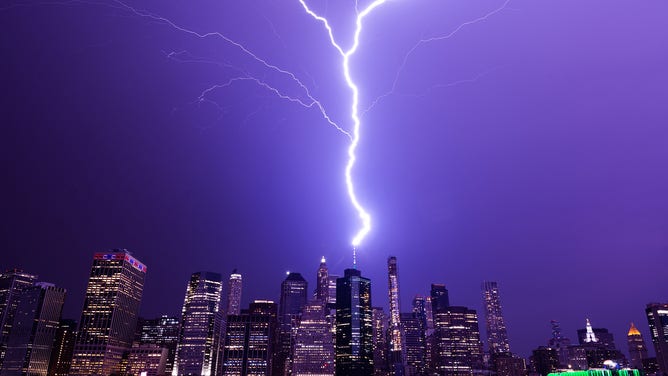Backwards bolt: Watch as lightning heads skyward from NYC's World Trade Center
A thunderstorm that rolled through New York City Monday night put on a dazzling display of lightning, including several bolts that struck the World Trade Center.
Lightning heads skyward from NYC's World Trade Center
At least 8 lightning strikes appeared to have struck the World Trade Center Monday night.
NEW YORK -- A thunderstorm that rolled through New York City Monday night put on a dazzling display of lightning, including several bolts that struck the World Trade Center.
"It was crazy watching it get hit so much," said FOX Weather's Christopher Scragg who was out photographing the storm.
Lightning detection equipment with Vaisala detected 15 cloud-to-ground lightning strikes within five miles of the building over a 45-minute period, with at least eight lightning strikes that appear to have struck the World Trade Center.

Map showing lightning strikes around Manhattan on Sept. 13, 2021.
At least one of those strikes, if not more, was a rare upward strike, where the bolt appears to begin with the building and travels toward the cloud, as opposed to traditional lightning strikes that go cloud to ground.
"Usually what happens when you have upward lightning is that you have a strong electric field go over the top of a tall object, like a skyscraper or radio tower, and upward leaders are initiated off the tower as a result," says meteorologist Chris Vagasky with Vaisala. "They connect with the electric field in the cloud and you get lightning."

Upward lightning strikes New York City's World Trade Center on Sept. 13, 2021.
(Christopher Scragg / FOX Weather)
Luckily, buildings – especially skyscrapers that are among the best at attracting lightning – are well protected against the strikes. A typical lightning strike can carry 300 million volts and 30,000 amps. That’s enough energy to power a 100-watt incandescent light bulb for around three months, the National Weather Service says.
Lightning rods to the rescue. The rods stick atop the highest point of the building, aiming to attract the lightning bolt. Once the bolt strikes, the rod safely channels the millions of volts of energy through copper or aluminum cables around the building and into the ground, thereby protecting from the massive energy surge had the strike come in via other means like wires or pipes.

Lightning strikes the World Trade Center in New York on Sept. 13, 2021.
(Christopher Scragg / FOX Weather)
And New York skyscrapers are certainly no strangers to being hit. The Empire State Building was one hit eight times in 24 minutes – not all that far off from this storm's feat. Though Vagasky said the WTC skyscraper may have had additional strikes as upward lightning is more difficult to detect so it's possible there were more than eight lightning hits with this storm.
What's somewhat surprising is that it doesn't appear the Empire State Building was struck at all in this storm. Vagasky said that building is 3 miles away and about 300 feet shorter, and being a taller building does make it more susceptible to lightning.
